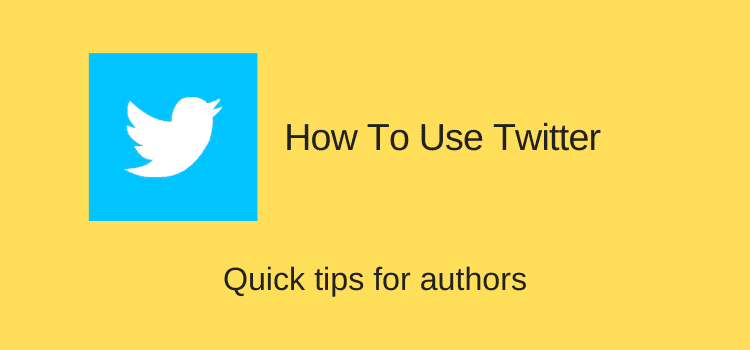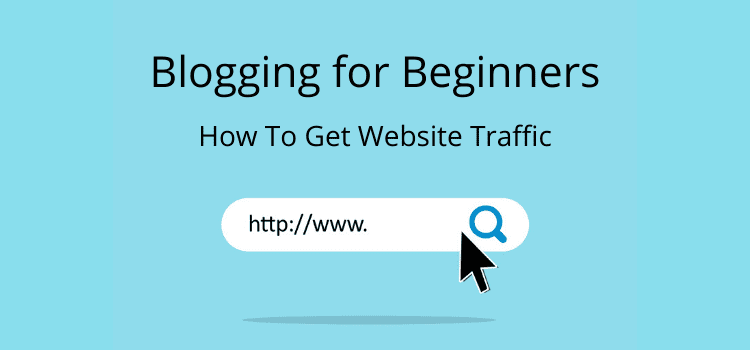
For beginners new to blogging, it can be challenging at first to attract website traffic. Or, in other words, getting regular readers for your new blog.
It doesn’t matter if you use a free blogging platform or self-hosted WordPress.
It takes time to attract regular visitors when you start blogging for the first time or even create a new second or third blog.
But on any blog platform, if you get the basics right first, you have a better chance of success.
Before you start
If you plan to set up a self-hosted WordPress blog, choose a reliable and fast web host.
You also need a lightweight theme.
Site speed and Core Web Vitals are a big deal now. So fast site loading speed is of the essence.
But the number one blogging for beginners tip is to register your new blog with Google Analytics (GA) and Google Search Console (GSC).
You can do this as soon as you create a blog and have your URL address.
These two tools are essential for tracking your new blog’s progress and analyzing your traffic sources.
With GSC, you can track your keyword and page rankings after you start writing blog posts.
If you have a new WordPress site, you can integrate Google Analytics easily by installing a plugin.
GA Analytics will add all the code for your site and allow you to track your traffic from your WordPress dashboard.
Once you are set up, you are ready to start blogging.
Blogging for beginners is a long road
If you are a new blog, website, or business owner, you can check your traffic stats with Google Analytics and other SEO tools.
In the first few months, your organic traffic data might look like the image below.
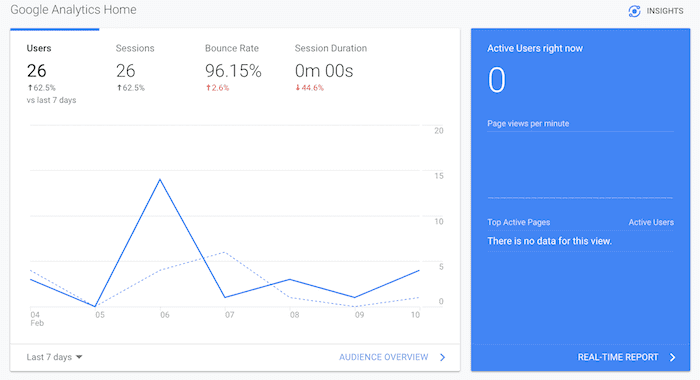
The site traffic data above is for a new blog I started about six months ago.
The weekly stats for search traffic are very low.
Also, the bounce rate is extremely high.
It is my fourth blog, and it is following the same pattern as my established blogs.
They all started slowly and took a long time to attract a steady volume of search results from search engines.
For one of my established blogs, you can see how the progression builds once a website ranks on Google and Bing.
But increasing website traffic is not linear.

As you can see it took a long time to get reasonable monthly traffic.
But the good news is that when it happens, it can happen quickly.
It is usually because of an algorithm update that recognizes the quality of a new site.
Why does it take so long for people to visit a new blog?
Establishing a new blog and getting traffic to your site takes a long time.
So many blogs and websites are competing for an audience that is not growing at anywhere near the same rate.
To give you some perspective, look at the growth in websites and blogs over the years.
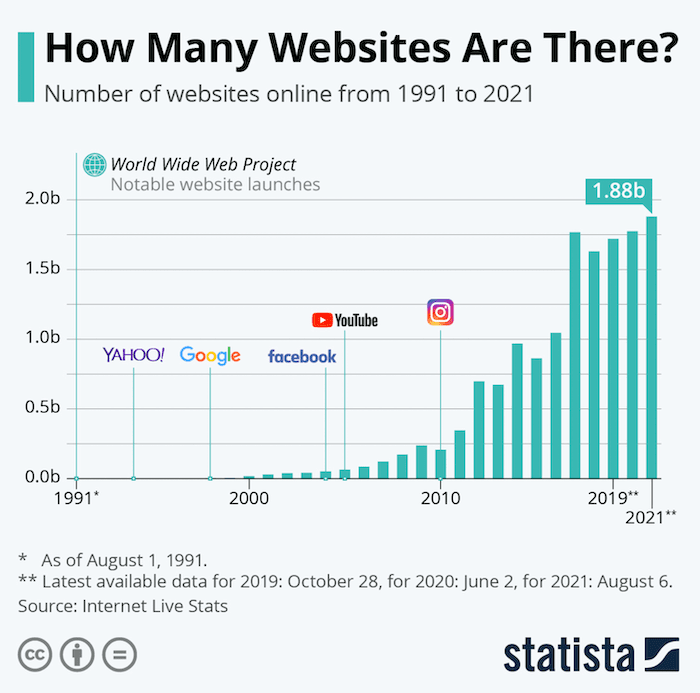
Most of the websites above are blogs or sites publishing articles and creating content.
The growth may be explained by the shift from social media marketing to content marketing in the last few years.
Content marketing or organic marketing uses an article or blog post as an advertising page for products and services.
Posts are written to attract targeted traffic by employing a range of search engine optimization (SEO) techniques.
It can be challenging for beginners new to blogging. More and more people are trying to make money blogging with advertising or affiliate links.
Blogs and websites are growing at a rapid rate. They publish a massive number of blog posts every day, as the image below shows.
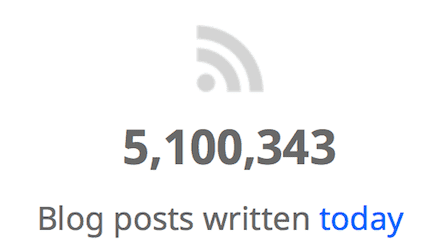
The statistics above from Internet Live Stats give you some perspective of where one new blog post on your site fits into today’s world on the Internet.
But for beginners who want to start blogging, it is not all gloom and doom.
There are proven ways you can rise above the crowd and encourage search engine indexing to become your primary traffic source.
The key to driving more traffic to your site is to rank.
All you need to do is understand how to rank.
Learning about ranking factors
If you are new to blogging, it is essential to know that many factors positively affect your blog’s monthly search results.
All of them take a long time to start working, unfortunately.
But when they do finally start to kick in, expect a jump in your web traffic and conversion rates.
Google uses around 200 ranking factors to rank web pages, but you don’t need to dig that deep.
Just make sure you have the two basics covered.
Check that your site or blog is loading quickly and is mobile-friendly.
Choose a modern and clean WordPress theme or a theme on your platform that looks appealing and is easy to read and navigate.
If your site is fast and looks good, there are five key factors that you need to concentrate on to improve your website traffic from search engines.
5 Key factors that will help improve your blog
1. Domain registration length: Difficulty level -Extremely easy
The following Google patent quote has appeared many times on SEO sites.
“Valuable (legitimate) domains are often paid for several years in advance, while doorway (illegitimate) domains rarely are used for more than a year. Therefore, the date when a domain expires in the future can be used as a factor in predicting the legitimacy of a domain.” source
While it is not written in stone, paying ahead for your domain name is good practice for your new blog or site.
The annual fee for your domain name is probably less than $10.00.
Paying two or three years in advance is a quick and easy way to give your new site some SEO legitimacy, and it can only positively affect your site’s ranking.
2. Write quality blog posts: Difficulty level – Medium
Without writing great content, you will go nowhere in blogging, especially if you want to monetize your blog.
You need to publish a lot of well-written, informative, and long-form articles on your site.
According to Backlinko, more extended content ranks higher in Google’s search results. The average Google first page result contains 1,890 words.
No matter your blog topic or the content you write, you should avoid short blog posts. Try to stay within the range of 1,000 to 2,500 words.
Most articles that rise to the top of search rankings answer questions or provide solutions for people.
If you keep in mind that people often type a form of a question into Google or Bing search, you can write your articles accordingly.
Also, ensure your writing is grammatically perfect and free of spelling errors and typos for your posts and landing pages.
You can use an online grammar checker to help you with this.
You need to publish at least 30-50 articles before you start to see any traction with search engines.
Yes, it is a long road. But keep in mind that your articles will keep working for you for years to come. So think of them as a long-term investment.
Another content tip is to update your articles. It is another positive Google ranking factor if you update a post and add more content.
Go back to some of your existing articles and see if you improve them by expanding the article or adding new images.
3. Add internal links: Difficulty level – Very easy
You are probably already adding external links to your blog posts. It is an excellent practice because you can validate your article with quality sources.
It is also a ranking factor, as search engines can see that you are linking to high-quality sites.
But an equally important ranking factor is internal linking.
By adding links between your articles, you are telling search engines how your content is connected.
It builds a hierarchy of the information you are writing about.
In a 1,500-word article, you should add two or three internal links to your other posts.
By adding internal links, you will increase your pages per visit.
Add one early in the article for readers who may not be so interested in your article but may be interested in something else.
Add another in the middle and one at the end.
The one at the end is very important because it encourages a reader who likes what you are writing about to want to read more.
Another golden rule with links is that you should always open external links in a new tab. By doing so, your reader still has your article open in its existing tab.
But for internal links, always open in the same tab. This makes sure your reader stays on your site.
4. Write around keywords: Difficulty level – Moderate
SEO keywords are the heart and soul of gaining search engine traffic and more unique visitors to your blog.
Most people who have visited your site will have arrived from a search engine.
Search keywords drive the whole Internet. So they will be one of your biggest traffic generators.
There are many ways you can research keywords for free.
Or, if you are determined to take a faster track, premium keyword research tools are available for pro bloggers.
A key point to understand is that one blog post can earn many keywords from search engines.
It is not unusual for one post to be indexed with 500 or more keywords, meaning that people have over 500 ways to find your post.
I won’t write a how-to guide for organic keywords in this post because I have covered the topic before.
The critical factor in writing around keywords is to understand how people search.
Finding the right search terms that people use and then including them in your text is the most proven way to achieve success for blog posts and articles.
5. Backlinks: Difficulty level – Very Hard
The top factor for search engine ranking is by far the hardest.
It is also the main reason a new blog takes so long to gain traction.
It is the number of backlinks you have earned from other blogs and websites that add a link back to your site or one of your articles.
Here is an example of some backlink data for ranking pages on Just Publishing Advice from Google Search Console.
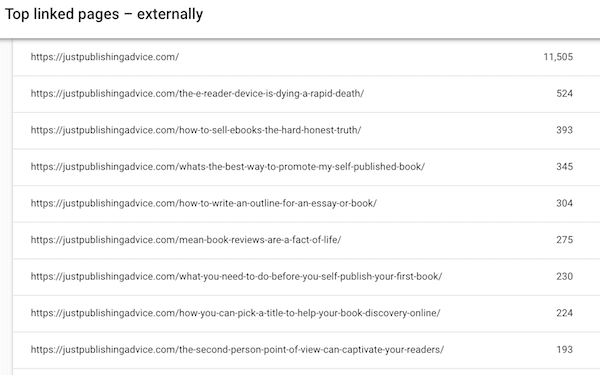
Until you can earn backlinks, your pages will struggle to rank, which is why my new blog has yet to get off the ground.
But it is the same for an existing blog that is doing well. New articles take a long time to rank, and it is mostly older articles that gain backlinks and produce the most traffic.
As a rule of thumb, posts over one-year-old usually bring in the bulk of the search traffic.
There are many ways of trying to gain backlinks.
Many bloggers think it is good SEO practice to send emails to a list of blogs after publishing a new article and ask for a backlink.
Unfortunately, this email marketing practice has become so popular that it borders on spamming. I get at least 20-25 of these emails every day, and they head straight to my junk folder.
A better way is to get to know some bloggers in your topic area and, from time to time, exchange, swap, or add links to each other’s articles. But don’t overdo it.
If you swap 100 links with one site and yours quickly, it will raise alarm bells with Google algorithms. You will lose, not gain, ranking.
A little goes a long way, so it is best to spread your exchange linking to only one or two per external site.
You can use guest blogging or guest posting to gain backlinks. It is helpful, but it’s very slow going.
Sharing your posts on a social network or two can sometimes get you a backlink from a blogger.
But in reality, the best way to gain backlinks is to earn them organically.
Bloggers add backlinks to an external site to prove a point, add a statistic, validate a theory, or add value to their article for their readers.
If you can write articles that fulfill these needs, you will get backlinks over time.
It then starts to work like the snowball effect.
Every new backlink you get will help you get more referral traffic, which will lead to getting more links, which will lead to more referral traffic.
That is why I say it is a long road to success with a new blog. But once the snowball starts, you are on your way.
Summary
Every successful blog started from zero. So for beginners is no different from the big names in blogging when they first started.
All you need to do is be patient and determined to see you through the challenging early period.
Stay focused on the essential elements that will help your blog grow.
Make sure you keep adding new quality articles regularly. Share your new content on social media.
Work on trying to leverage low-difficulty keywords. Work on your internal linking and keep updating your existing posts.
In time, readers and search engines will start noticing your hard work.
For beginners, it might seem like blogging is slow going. But it will work for you in the long run if you are patient.
Related reading: The Differences Between An Article And A Blog Post

